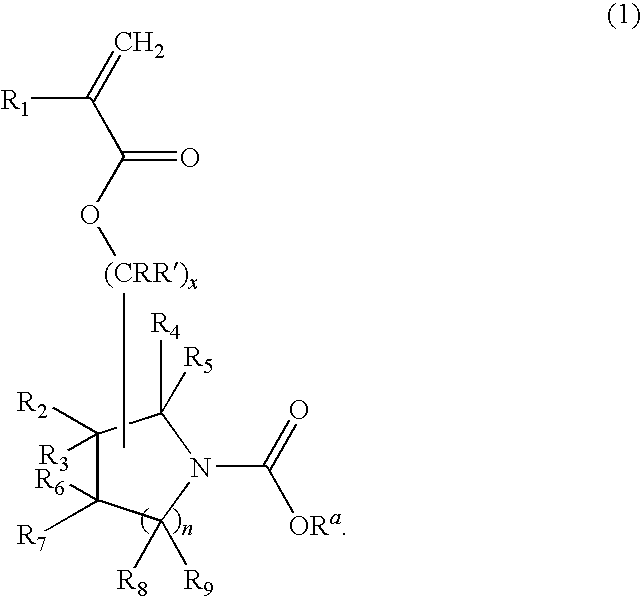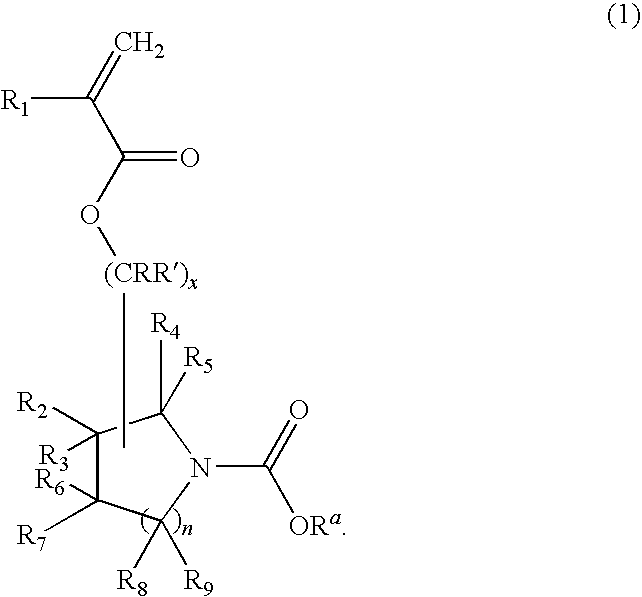(Meth)acrylate compound, photosensitive polymer, and resist composition including the same
a technology of acrylate compound and resist, which is applied in the direction of photosensitive materials, instruments, photomechanical equipment, etc., can solve the problems of reduced process margin of underlayer etching, reduced line width roughness (lwr), and reduced resistance material using arf excimer lasers. , to achieve the effect of reducing lwr, reducing process margin, and being easy to prepar
- Summary
- Abstract
- Description
- Claims
- Application Information
AI Technical Summary
Benefits of technology
Problems solved by technology
Method used
Image
Examples
preparation example 1
Tert-butyl-4-(methacryloyloxy)piperidine-1-carboxylate salt
[0077]
[0078]According to the process as shown in Reaction Scheme 1, a tert-butyl-4-methacryloyloxypiperidine-1-carboxylate salt was synthesized.
[0079]In particular, 25.4 g of tert-butyl-4-hydroxypiperidine-1-carboxylate salt and 0.771 g of 4-dimethylaminopyridine were dissolved in 170 mL of methylene chloride. Then, 30.8 mL of diisopropylethylamine and 22.6 mL of methyl-propenoic anhydride were added thereto. The resulting product was reacted at a room temperature for about 15 hours.
[0080]After the reaction was complete, the reactant was diluted in an excess of ethyl acetate, and the diluted product was rinsed with a saturated sodium bicarbonate solution and a saturated sodium chloride solution. Then, a predetermined amount of sodium sulfate was added to the rinsed product and was agitated for about 15 minutes. The agitated product was filtered to remove sodium sulfate, and the solvent was removed from the resulting material...
preparation example 2
Synthesis of Photosensitive Polymer
[0085]3 mmol of the tert-butyl-4-(methacryloyloxy)piperidine-1-carboxylate salt synthesized according to Preparation Example 1, 35 mmol of γ-butyrolactonyl methacrylate (GBLMA), 35 mmol of 2-methyl-2-adamantyl methacrylate (MAMA) and 30 mmol of 3-hydroxy-1-adamantyl methacrylate (HAMA) were put in a flask and dissolved with propyleneglycol monomethyl ether acetate (PGMEA) solvent in a 3:1 weight ratio of solvent to the total weight of monomers therein. Then, 15 mmol of dimethyl-2,2′-azobis(2-methylpropinonate) (V601, Wako Pure Chemical Industries Ltd.) was added thereto as a polymerization initiator. The mixture solution was polymerized at a temperature of 80° C. for 4 hours.
[0086]When the polymerization was complete, the reactant was slowly precipitated in an excess amount of a hexane solvent. The precipitate was filtered and dissolved in an appropriate amount of dioxane. The solution was then re-precipitated in methanol. Then, the precipitate was...
preparation example 3
Preparation of a Resist Composition and Lithography Performance
[0087]A resist composition was prepared by completely dissolving 0.8 g of the photosensitive polymer according to Preparation Example 2 and 0.02 g of a triphenylsulfonium nonaflate photoacid generator in 17 g of propyleneglycol monomethyl etheracetate / ethyl lactate (6 / 4 volume ratio) and then, completely dissolving 1 mg of triethanol amine, as an organic base.
PUM
| Property | Measurement | Unit |
|---|---|---|
| polydispersity | aaaaa | aaaaa |
| wavelength | aaaaa | aaaaa |
| wavelength | aaaaa | aaaaa |
Abstract
Description
Claims
Application Information
 Login to View More
Login to View More - R&D
- Intellectual Property
- Life Sciences
- Materials
- Tech Scout
- Unparalleled Data Quality
- Higher Quality Content
- 60% Fewer Hallucinations
Browse by: Latest US Patents, China's latest patents, Technical Efficacy Thesaurus, Application Domain, Technology Topic, Popular Technical Reports.
© 2025 PatSnap. All rights reserved.Legal|Privacy policy|Modern Slavery Act Transparency Statement|Sitemap|About US| Contact US: help@patsnap.com



